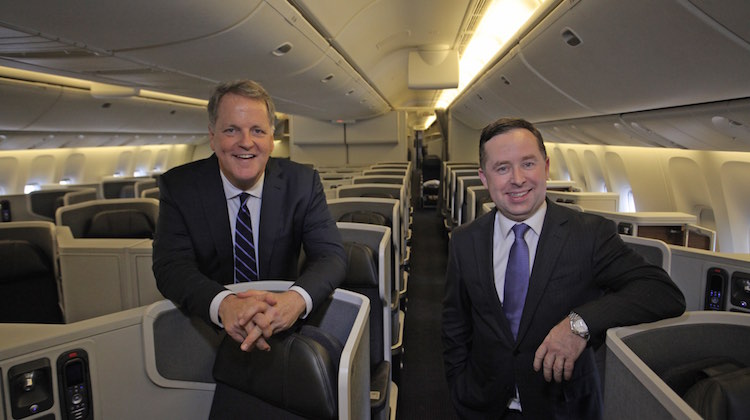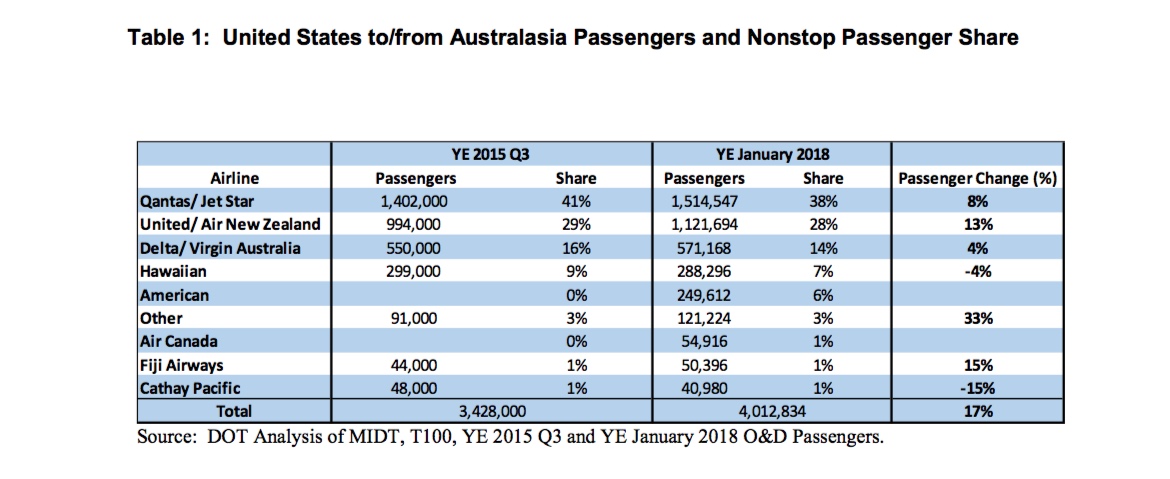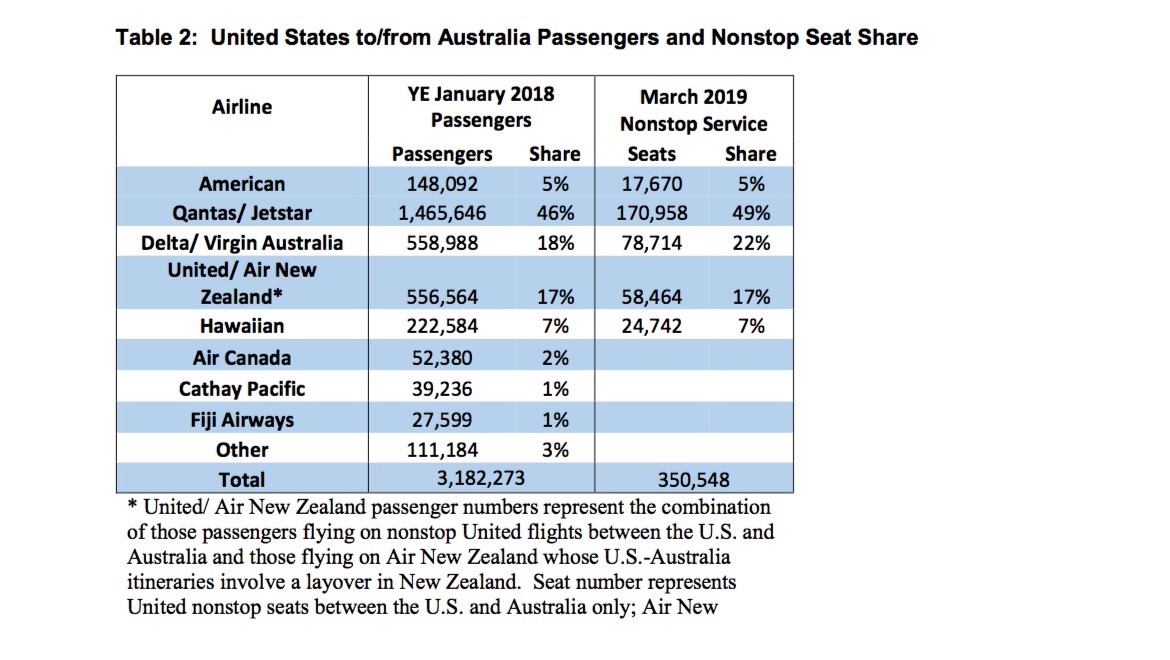
The United States government has granted American Airlines and Qantas “tentative approval” to form a joint-venture alliance on trans-Pacific routes with anti-trust immunity.
The Department of Transportation (DOT) announced its decision on the pair’s application on Monday (US time).
The ruling, which is still subject to a public comment period, would allow American Airlines and Qantas establish a metal-neutral, revenue-sharing partnership on routes across the Pacific.
The DOT has placed some conditions on the alliance, such as an obligation to provide interline access for any new airline flying from Australia and New Zealand to the United States, as well as requirements to submit origin and destination data and an annual report.
The DOT has also called for the two carriers to submit a “detailed self-assessment after seven years”.
“The Department has tentatively decided to approve the proposed alliance agreements submitted by American and Qantas, and to confer a grant of antitrust immunity, subject to conditions,” the DOT said in its decision.
“Our analysis below tentatively finds that substantial public benefits are likely to result from the proposed immunized cooperation, and that the benefits can only be achieved with a grant of antitrust immunity.
“These benefits are likely to include additional seat capacity and the retention and expansion of current flights and codeshares, schedule optimization, the elimination of “double marginalization” or double markups, technological investments that will increase seat availability for connectivity between the carriers at key US gateways, thereby stimulating and growing the market, and other customer service enhancements.”

If at first you don’t succeed
The tentative approval reverses a prior DOT ruling two and a half years ago, when the department issued a Show Cause Order knocking back the pair’s initial application to forge a deeper alliance.
The Show Cause Order, published on November 18 2016, noted the combined Qantas-American Airlines network would represent 60 per cent of all seats between the US and Australia and that there was a “high risk of competitive harm from granting the pair ATI.
Further, it said the two carriers would have the largest market share in about 200 city-pair markets. This would be sufficient for the alliance to “exert market power”.
Qantas and American withdrew their application in response to the Show Cause Order and then wound back some elements of cooperation that were in place at the time that did not require ATI.
The pair then submitted a fresh application in February 2018, which said the alliance would generate an estimated US$310 million annually in incremental consumer benefits should it be approved.
This comprised US$221 million from codeshare availability improvements and US$89 million comes from an eight per cent reduction in price per interline ticket, the airlines said.
There would also be a forecast 180,000 new market passengers, stimulated by additional codesharing and new flights.
However, being prevented from having deeper partnership would place at risk some trans-Pacific flights, such as Qantas’s Sydney-Dallas/Fort Worth and American’s Los Angeles-Sydney and Los Angeles-Auckland services.
In the tentative decision, the DOT outlined three relevant facts and circumstances that now supported approval.
First, the DOT said market conditions had evolved since 2016, which “mitigate any competitive harm that an American/Qantas joint venture could cause”.
“While Qantas and American could achieve approximately 44 percent share under ATI, data shows that aligned and unaligned carriers are competing effectively,” the DOT said.
“While the proposed alliance would modestly expand overall market share for the Joint Applicants, the Department notes that carriers such as Air New Zealand, Air Canada, Cathay Pacific, Fiji Airways, and others offering connectivity via intermediate points have increased their share of the overall US–Australia market, and the total number of passengers has increased by 16 per cent.”


Second, the DOT said American Airlines and Qantas had changed the structure of their joint-venture to “address dynamics in this ultra-long-haul market”.
And third, the DOT said the pair provided extensive evidence that their joint venture plans were “likely to enhance competition and deliver new and valuable consumer benefits”.
“Even though the proposed alliance is likely to be pro-competitive and beneficial to consumers, our analyses indicates that positive competitive effects are less certain than in previous cases,” the DOT said.
The two carriers have pledged to introduce three new routes within two years of receiving DOT approval.

Qantas group chief executive Alan Joyce said the partnership would bring significant benefits to millions of travellers and boost tourism.
“For more than 30 years, Qantas and American have connected the US and Australia as partners. This joint business means that we’ll be able to deepen this partnership to offer new routes, better flight connections and more frequent flyer benefits,” Joyce said in a statement.
American Airlines chief executive Doug Parker added: ““As was evident in the unprecedented level of public support for this application, the joint business will also create additional jobs at our respective companies and in the industries we serve.”
Qantas said it planned to introduce two new routes – Brisbane-San Francisco and Brisbane-Chicago – once final approval was received.
Currently, the Australian carrier flies from Brisbane to Los Angeles, Sydney to Dallas/Fort Worth, Los Angeles, New York JFK and San Francisco, and Melbourne to Los Angeles and San Francisco. Its Sydney-Honolulu flights were not part of the proposed alliance.
Meanwhile, American Airlines serves Auckland (seasonal) and Sydney from Los Angeles.
The Australian Competition and Consumer Commission (ACCC) and New Zealand Minister of Transport had approved approval for the Qantas-American joint business agreement in 2016.
The full decision can be found on the United States’ Regulations.gov website. The DOT comment period in response to its decision is open for the next two weeks.
















Lechuga
says:Now let’s get an AA to Melbourne service going.
Harrison
says:Does this means American Airlines could be starting Melbourne-Los Angeles or Brisbane-Los Angeles flights anytime soon
Red Cee
says:Good news. Common sense has finally prevailed.
Craigy
says:I understand the American Airlines new route is going to be MEL-DFW. So probably a B788 or B789.